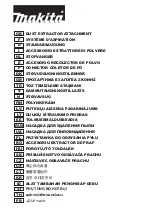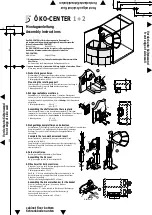
Proximity Sensors Technical Guide
Turning OFF the Power
An output pulse may be generated when the power is turned OFF, so
design the system so that the load or load line power turns OFF first.
Influence of Surrounding Metal
The existence of a metal object other than the sensing object near the
sensing surface of the Proximity Sensor will affect detection perfor-
mance, increase the apparent operating distance, degrade tempera-
ture characteristics, and cause reset failures. For details, refer to the
influence of surrounding metal table in
Safety Precautions
for individ-
ual Sensors.
The values in the table are for the nuts provided with the Sensors.
Changing the nut material will change the influence of the surrounding
metal.
Power Transformers
Be sure to use an insulated transformer for a DC power supply. Do
not use an auto-transformer (single-coil transformer).
Precautions for AC 2-Wire/DC 2-Wire Sensors
Surge Protection
Although the Proximity Sensor has a surge absorption circuit, if there
is a device (motor, welder, etc.) that causes large surges near the
Proximity Sensor, insert a surge absorber near the source of the
surges.
Influence of Leakage Current
Even when the Proximity Sensor is OFF, a small amount of current
runs through the circuit as leakage current.
For this reason, a small current may remain in the load (residual
voltage in the load) and cause load reset failures. Verify that this
voltage is lower than the load reset voltage (the leakage current is
less than the load reset current) before using the Sensor.
Using an Electronic Device as the Load for an AC 2-Wire
Sensor
When using an electronic device, such as a Timer, some types of
devices use AC half-wave rectification. When a Proximity Sensor is
connected to a device using AC half-wave rectification, only AC half-
wave power will be supplied to the Sensor. This will cause the Sensor
operation to be unstable. Also, do not use a Proximity Sensor to turn
the power supply ON and OFF for electronic devices that use DC half-
wave rectification. In such a case, use a relay to turn the power supply
ON and OFF, and check the system for operating stability after
connecting it.
Examples of Timers that Use AC Half-wave Rectification
Timers: H3Y, H3YN, H3RN, H3CA-8, RD2P, and H3CR (-A, -A8, -AP,
-F, -G)
Countermeasures for Leakage Current (Examples)
AC 2-Wire Sensors
Connect a bleeder resistor to bypass the leakage current flowing in
the load so that the current flowing through the load is less than the
load reset current.
Calculate the bleeder resistance and allowable power using the
following equation.
P
: Watts of bleeder resistance (the actual number of watts
used should be several times this number)
I
: Load current (mA)
It is recommend that leeway be included in the actual values used.
For 100 VAC, use 10 k
Ω
or less and 3 W (5 W) or higher, and for 200
VAC, use 20 k
Ω
or less and 10 W (20 W) or higher. If the effects of
heat generation are a problem, use the number of watts in
parentheses ( ) or higher.
DC 2-Wire Sensors
Connect a bleeder resistor to bypass the leakage current flowing in
the load, and design the load current so that (leakage current)
×
(load
input impedance) < reset voltage.
Calculate the bleeder resistance and allowable power using the
following equation.
P
: Watts of bleeder resistance (the actual number of watts
used should be several times this number)
i
R
: Leakage current of Proximity Sensor (mA)
i
OFF
: Load reset current (mA)
It is recommend that leeway be included in the actual values used.
For 12 VDC, use 15 k
Ω
or less and 450 mW or higher, and for 24
VDC, use 30 k
Ω
or less and 0.1 W or higher.
R
≤
Vs
(k
Ω
)
P >
Vs
2
(mW)
10 - I
R
R
≤
Vs
(k
Ω)
P >
Vs
2
(mW)
i
R
- i
OFFR
R
When using an AC 2-Wire Sensor, connect a bleeder
resistor so that the Proximity Sensor current is at least 10
mA, and the residual load voltage when the Proximity
Sensor is OFF is less than the load reset voltage.
Bleeder resistor R
Load
AC power supply
voltage Vs
Vs
Bleeder resistor R
Load
http://www.ia.omron.com/
C-4
(c)Copyright OMRON Corporation 2007 All Rights Reserved.



































